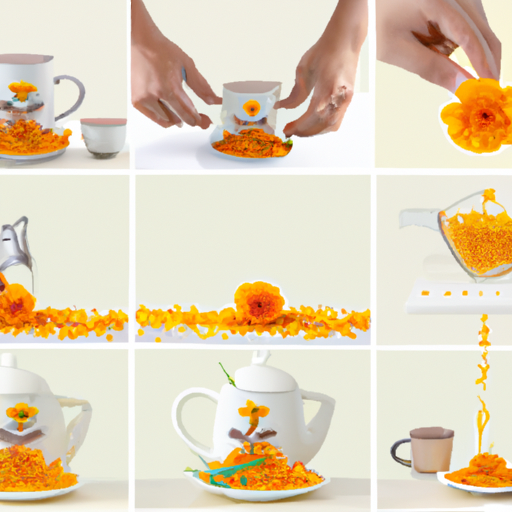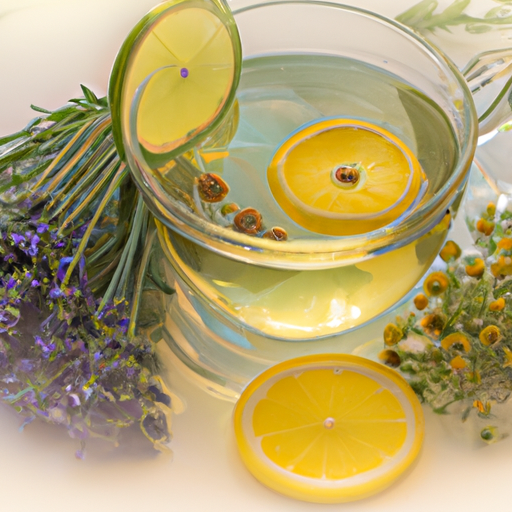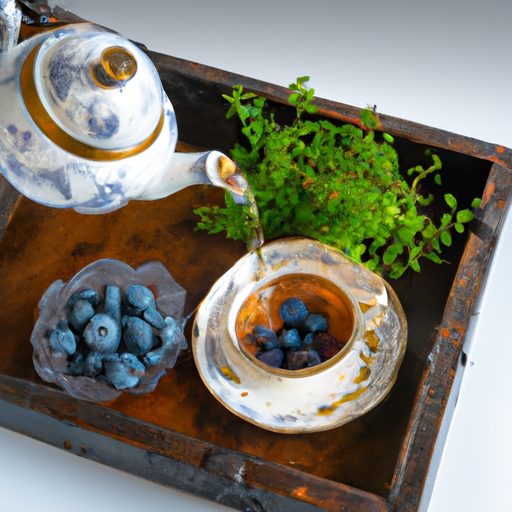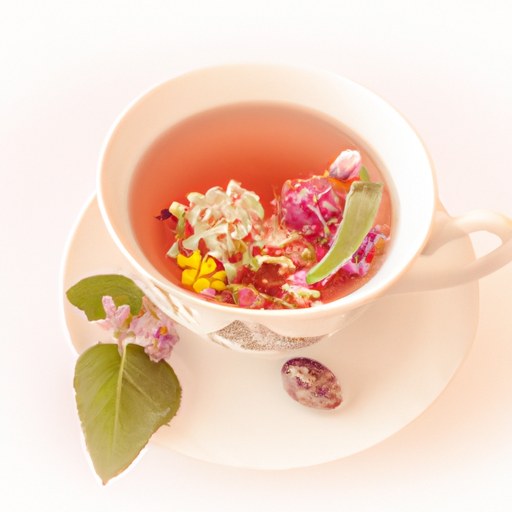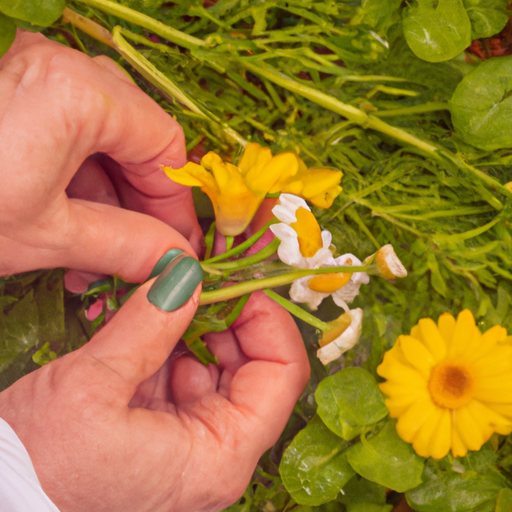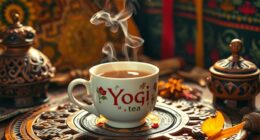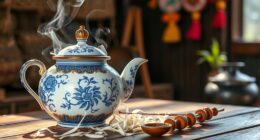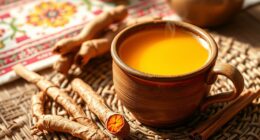Have you ever wanted to create a calming drink that not only tastes good but also has benefits for your body and spirit? Well, get ready to explore the realm of herbal tea, where flavors and scents come together to promote overall well-being.
Just like an artist carefully selects colors for their masterpiece, choosing the right herbs for your herbal tea blend is crucial. But fear not, for I am here to guide you through the magical process of brewing the perfect cup of herbal tea. From selecting the finest ingredients to enhancing the flavors, I will show you the secrets to creating a truly remarkable beverage.
So, grab your favorite mug, gather your herbs, and let the alchemy begin! Get ready to experience the meditative ritual of preparing and enjoying your own homemade herbal tea. Your journey awaits, and I am honored to be your guide.
Key Takeaways
- Selecting the right herbs for your herbal tea blend is essential for both flavor and health benefits.
- Experimenting with different combinations of herbs can help you create unique and soothing elixirs.
- Using fresh herbs and properly drying and storing them will ensure the best taste, aroma, and benefits in your tea.
- Enhancing the flavor of your herbal tea by adding citrus fruits, spices, or sweeteners can create a delightful and refreshing beverage.
Selecting the Right Herbs for Your Herbal Tea Blend
You’ll want to carefully choose the herbs that you include in your herbal tea blend, as each herb brings its own unique flavor profile and potential health benefits to the mix. Choosing the right herbal tea blend is essential to creating a delicious and beneficial beverage.
There are countless herbs to choose from, each with its own distinct flavor and properties. For a calming and soothing tea, you might consider chamomile or lavender. If you’re looking for a refreshing and invigorating blend, peppermint or lemon balm would be great choices. Green tea and ginger are known for their metabolism-boosting properties, while hibiscus and rosehips are rich in antioxidants.
Experimenting with different combinations can be fun and exciting, allowing you to create a blend that perfectly suits your taste and health goals.
Once you have selected your herbs, it’s time to move on to preparing your tea ingredients by drying and storing them properly.
Preparing Your Tea Ingredients
To get the perfect blend, it’s important to gather all the necessary ingredients for your soothing cup of herbal tea. Exploring different tea blends is a great way to find your favorite flavors and combinations. Whether you prefer a calming chamomile or an invigorating peppermint, there are endless possibilities to create your own unique blend.
When preparing your tea ingredients, it’s crucial to use fresh herbs. Fresh ingredients not only provide the best taste and aroma but also ensure that you’re getting the full benefits of the herbs’ natural properties. Avoid using dried herbs that have been sitting in your pantry for months, as they may have lost their potency and flavor. Instead, opt for fresh herbs from your garden or purchase them from a trusted source.
To make the most of your herbal tea, here’s a helpful list of ingredients to consider:
- Lavender: Known for its calming properties and delicate floral aroma.
- Lemon Balm: Offers a refreshing citrus flavor and helps reduce stress and anxiety.
- Ginger: Adds a warming kick and aids digestion.
- Rosehips: Rich in vitamin C and adds a slightly tart flavor.
- Peppermint: Provides a refreshing and cooling taste.
With these fresh ingredients in hand, you’re ready to move on to the next step: brewing methods for herbal tea.
Brewing Methods for Herbal Tea
Once you’ve gathered your fresh ingredients, it’s time to brew your soothing cup of herbal tea using various methods.
There are several brewing techniques to choose from, each offering a unique flavor profile and extracting different health benefits from the herbs.
One common method is steeping, where you simply pour hot water over the herbs and let them sit for a few minutes. This method is ideal for delicate herbs like chamomile or lavender, as it ensures a gentle infusion of their flavors.
Another technique is simmering, which involves boiling the herbs in water for a longer period of time. This method is great for extracting the medicinal properties of herbs like ginger or echinacea.
Lastly, there’s the cold brew method, where you let the herbs steep in cold water overnight. This technique is perfect for herbs that release their flavors more slowly, such as hibiscus or rose petals.
Once you’ve mastered these brewing techniques, you can move on to enhancing the flavor of your herbal tea by adding complementary ingredients like lemon or honey.
Enhancing the Flavor of Your Herbal Tea
When it comes to enhancing the flavor of herbal tea, there are a few key points to consider. One way to add a burst of flavor is by incorporating citrus fruits or zest, which can provide a refreshing and tangy twist.
Additionally, sweeteners and spices can be used to create a perfect balance of taste, allowing you to customize your tea to suit your preferences. By experimenting with these ingredients, you can elevate the flavor profile of your herbal tea and create a truly delightful experience.
Adding Citrus Fruits or Zest
Enhance your herbal tea with a burst of refreshing citrus fruits or zest! Citrus fruits, such as lemons, oranges, and limes, not only add a tangy and zesty flavor to your tea but also provide numerous health benefits.
Citrus fruits are rich in vitamin C, which can boost your immune system and improve your skin health. They also contain antioxidants that help fight against free radicals and reduce the risk of chronic diseases.
Adding citrus fruits to your herbal tea can also be a great way to experiment with different flavors and create unique combinations. So, whether you’re looking to add a hint of acidity or a touch of brightness to your tea, incorporating citrus fruits or zest is a fantastic option.
Now, let’s move on to the next section about incorporating sweeteners and spices to further enhance the taste of your herbal tea.
Incorporating Sweeteners and Spices
To make your cup of herbal goodness even more delightful, you can add a touch of sweetness and a burst of spice. There are various sweetening options to choose from when preparing herbal tea. You can use natural sweeteners such as honey, maple syrup, or stevia, which add a pleasant sweetness without overpowering the herbal flavors.
For a more indulgent treat, you can try adding a sprinkle of cinnamon, a dash of nutmeg, or a pinch of cardamom to your tea. These spice combinations not only enhance the taste but also provide added health benefits. Cinnamon, for example, is known for its anti-inflammatory properties, while cardamom aids digestion.
Now that we’ve added some sweetness and spice, let’s move on to the next step of steeping and straining your herbal tea.
Steeping and Straining Your Herbal Tea
Steeping your herbal tea releases the soothing aroma and flavors that’ll transport you to a state of tranquility. Proper steeping techniques are crucial to ensure the perfect cup of herbal tea.
Begin by bringing filtered water to a boil and then allow it to cool for a minute or two. This’ll help preserve the delicate flavors of the herbs.
Next, place your herbal tea blend in a tea infuser or tea bag. For loose leaf tea, use approximately one teaspoon per cup of water. Carefully pour the hot water over the tea and let it steep for the recommended time, usually around 5-7 minutes. During this time, the herbs’ll infuse the water, creating a rich and flavorful brew.
Once the steeping time’s complete, it’s time to strain your herbal tea. Remove the tea infuser or tea bag and discard. If you used loose leaf tea, strain the tea through a fine mesh strainer to remove any remaining particles. This’ll result in a smooth and clear tea.
Now that your herbal tea’s perfectly steeped and strained, it’s time to move on to the next step: serving and enjoying your herbal tea. With a cup in hand, you can sip and savor the comforting flavors while embracing the peacefulness of the moment.
Serving and Enjoying Your Herbal Tea
When it comes to enjoying herbal tea, I often find myself torn between indulging in a steaming cup of hot tea or sipping on a refreshing glass of iced herbal tea. The choice ultimately depends on my mood and the weather outside.
Additionally, I love pairing my herbal tea with a perfectly chosen snack or dessert. The flavors of herbal tea can complement a wide variety of treats, enhancing the overall experience and creating a delightful combination of flavors.
Hot vs. Iced Herbal Tea
If you’re looking to cool down on a hot day, sipping on a refreshing glass of chilled herbal tea might just do the trick. While hot herbal tea is perfect for warming up during colder months, iced herbal tea offers a delightful way to beat the heat. Not only does it provide a soothing and hydrating experience, but it also comes with numerous health benefits.
The cold temperature helps to refresh your body and quench your thirst, while the herbal infusion offers a variety of antioxidants and vitamins. From calming chamomile to invigorating peppermint, there are endless options to choose from.
So, grab a tall glass filled with ice and pour in your favorite herbal tea for a refreshing and healthy beverage. Now, let’s explore how to pair herbal tea with snacks or desserts.
Pairing Herbal Tea with Snacks or Desserts
Now that we’ve explored the difference between hot and iced herbal tea, let’s move on to the exciting topic of pairing herbal tea with snacks or desserts.
Herbal tea can be a delightful accompaniment to a variety of savory dishes, enhancing the flavors and providing a refreshing balance. Not only does herbal tea add a burst of taste to your meal, but it also offers numerous benefits for digestion. The soothing properties of certain herbal teas can aid in digestion, alleviating any discomfort that may arise after a hearty meal.
With their natural ingredients and gentle flavors, herbal teas are a perfect choice for those looking to enhance their dining experience. So, grab your favorite herbal tea and get ready to explore the world of unique and exotic recipes that will take your tea-drinking journey to new heights.
Exploring Unique and Exotic Herbal Tea Recipes
Discover a world of flavor and excitement with these unique and exotic herbal tea recipes. Herbal tea is not only delicious, but it also offers a wide range of health benefits. By exploring different blends, you can create a tea experience that is both satisfying and beneficial for your well-being.
Here are some unique tea blends that you can try:
-
Chamomile and Lavender: This calming blend is perfect for relaxation and promoting better sleep. It has a soothing aroma and can help reduce anxiety and stress.
-
Hibiscus and Ginger: This blend is vibrant and refreshing. It is packed with antioxidants and can help boost your immune system.
-
Peppermint and Lemon: This invigorating blend is perfect for a morning pick-me-up. It aids digestion and has a refreshing taste.
-
Rooibos and Vanilla: This blend has a smooth and creamy flavor. It is rich in antioxidants and can help improve skin health.
-
Lemongrass and Mint: This blend is both refreshing and uplifting. It can help improve digestion and reduce inflammation.
Incorporating these unique herbal tea blends into your routine can provide a delightful and healthful experience. So why not try experimenting with these recipes and discover a whole new world of flavors and benefits?
Frequently Asked Questions
Can I use fresh herbs instead of dried herbs for herbal tea?
Using fresh herbs in herbal tea has its benefits. A study found that fresh herbs contain higher levels of essential oils, resulting in a more flavorful and aromatic tea. Plus, they offer more antioxidants and nutrients compared to dried herbs.
Can I mix different types of herbal tea together?
Yes, you can mix different types of herbal tea together. Combining herbs can enhance the flavors and provide a variety of health benefits. Experiment with different combinations to find the perfect blend that suits your taste and needs.
How long should I steep herbal tea for maximum flavor?
To enhance the taste of herbal tea, steep it for at least 5 minutes. Steeping for longer periods, like 10 minutes, can extract more flavor and increase the benefits of the herbs.
Can I reuse the herbs for a second infusion?
Yes, you can definitely reuse herbs for a second infusion of herbal tea. Reusing herbs not only saves money but also allows you to enjoy the benefits of the herbs for longer.
Can I add sweeteners or milk to my herbal tea?
Yes, you can add sweeteners like honey or stevia to enhance the flavor of your herbal tea. However, adding milk is not recommended as it may overpower the delicate herbal flavors.
Conclusion
In conclusion, herbal tea isn’t just a delicious and soothing beverage, but it also offers a range of health benefits. By carefully selecting and preparing the right herbs, using proper brewing methods, and enhancing the flavor, you can create a truly enjoyable tea experience.
For example, a case study by a renowned herbalist showed that a blend of chamomile, lavender, and lemon balm helped reduce anxiety and promote relaxation in individuals. So, why not explore the world of herbal tea and discover your own unique and exotic recipes?
Cheers to a healthier and tastier tea journey!


